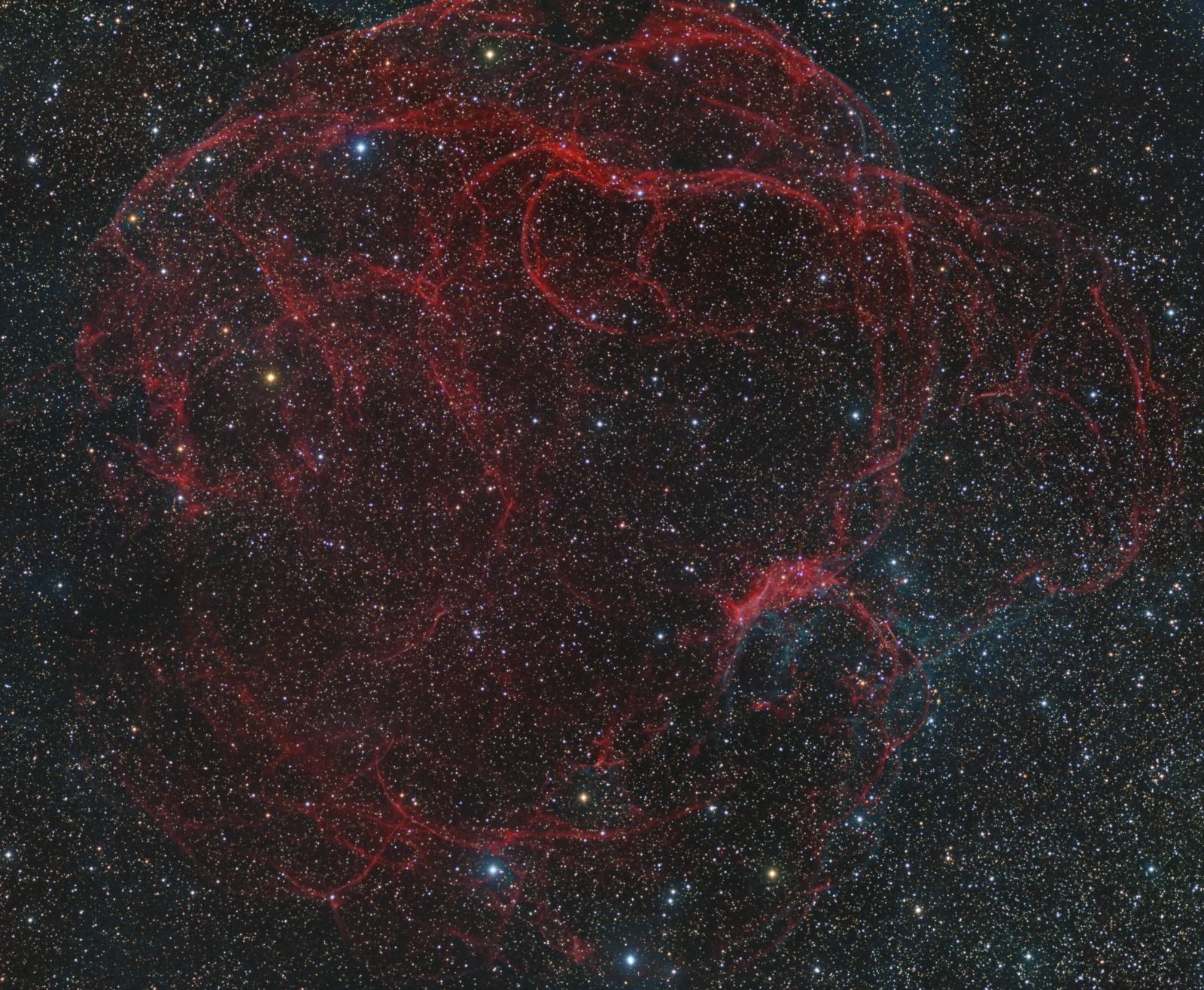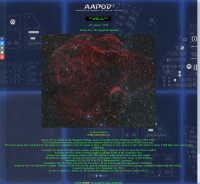Simeis 147 Supernova Remnant
 Click image for full size version
Click image for full size version
December 10, 2017, Space.com Image of the Day 14/12/2017, Amateur Astronomy Picture of the Day 18/8/2018

 Simeis 147 is known as the Spaghetti Nebula, and is a member of the Sharpless Catalogue (Sh2-240). It is a supernova remnant, produced by the explosive death of a large star about 40,000 years ago. The shock waves that resulted from the supernova explosion cause the gases to glow – hydrogen in red; oxygen in teal. This object is about 3,000 light years away and is expanding. Currently it is about 150 light years across, covering about 3 degrees of sky (6 times the Moon’s width). A pulsar near the centre of this complex is all that is left of the progenitor star. Pulsars are rapidly spinning neutron stars that appear to blink on and off as seen from earth.
Simeis 147 is known as the Spaghetti Nebula, and is a member of the Sharpless Catalogue (Sh2-240). It is a supernova remnant, produced by the explosive death of a large star about 40,000 years ago. The shock waves that resulted from the supernova explosion cause the gases to glow – hydrogen in red; oxygen in teal. This object is about 3,000 light years away and is expanding. Currently it is about 150 light years across, covering about 3 degrees of sky (6 times the Moon’s width). A pulsar near the centre of this complex is all that is left of the progenitor star. Pulsars are rapidly spinning neutron stars that appear to blink on and off as seen from earth.
While images of this object usually show the red structures caused by the glow of ionized hydrogen, I haven’t seen any that capture so much of the teal-coloured emissions of oxygen. The diffuse areas of O3 just right and left of top centre could be artifacts or real structures. A couple of other images I’ve seen appear to show these regions, but most do not. If you image this area, go deep on the O3 and let me know what you find.
Tekkies:
Moravian G3-16200 EC camera (on loan from O’Telescope), Optolong Ha, O3, R, G and B filters, Takahashi FSQ-106 ED IV at f/3.6, Paramount MX, unguided. Acquisition with the SkyX, focused with FocusMax. All pre-processing and processing in PixInsight. Acquired from my SkyShed in Guelph. Gibbous to full moon for Ha, new to crescent moon for O3 and RGB. Average or better transparency and seeing. Acquired September 21 – November 21, 2017.
51x5m R, 48x5m G, 49x5m B, 29×10 Ha and 29x10m O3 unbinned frames (total=22hr).
NB-RGB Processing
Creation and cleanup: The BatchPreProcessing script was used to perform calibration, cosmetic correction and registration of all frames. DrizzleIntegration was used to make the channel masters. The R, G, B, Ha and O3 masters were cropped to remove edge artifacts and DynamicBackgroundExtraction was applied to each. R, G and B were combined to make an RGB image which was processed with BackgroundNeutralization and ColorCalibration.
O3 halo removal: The O3 channel was processed using my method to reduce halos around bright stars. A noise-weighted blend of the Green and Blue channels was used in this process.
Combining Ha, O3 and RGB data: The NBRGBCombination script was run using RGB image for broadband, Ha for red narrowband and O3 for green and blue narrowband. PhotometricColorCalibration was applied.
Linear Noise Reduction: MultiscaleLinearTransform was used to reduce noise in the NB-RGB image. Layer settings for threshold and strength: Layer 1: 4.0, 0.92 Layer 2: 3, 0.65 Layer 3: 2, 0.43 Layer 4: 1.0, 0.25 Layer 5: 0.5, 0.14. A linear mask was used (amplification 150; smoothness 0.9).
Stretching: HistogramTransformation was applied to the NB-RGB image to make a pleasing, bright image.
Luminance Processing
Immediately prior to linear noise reduction, RGBWorkingSpace was applied to the NB-RGB image with all channel weights set to 1. The Luminance was extracted and processed separately as follows:
Deconvolution: A star mask was made to use as a local deringing support image. A copy of the image was stretched to use as a range mask, limiting deconvolution to the brightest regions of the image. Deconvolution was applied (50 iterations, regularized Richardson-Lucy, external PSF made using DynamicPSF tool with 30 stars).
Linear Noise Reduction: MultiscaleLinearTransform was used to reduce noise in the background areas. Layer settings for threshold and strength: Layer 1: 3, 0.74 Layer 2: 2, 0.52 Layer 3: 1.5, 0.25 Layer 4: 1.0, 0.11. A linear mask was used (amplification 130; smoothness 0.5).
Stretching: HistogramTransformation was applied to the Luminance to make a pleasing, bright image.
Noise Reduction and Re-Stretch: TGVDenoise was applied in Lab mode with 300 iterations with a range mask used to protect high signal areas. This was followed by a HistogramTransformation to raise the black point (but with no clipping).
Combining Luminance with NB-RGB:
The Luminance was applied to the NB-RGB image using LRGBCombine.
Additional Processing
Contrast Enhancement: ExponentialTransformation was applied to the faintest regions of nebulosity (PIP mode, order 0.8, no smoothing, Lightness Mask selected) using a mask to protect stars.
Final Steps: MultiscaleLinearTransform was used to sharpen the structures in the bright parts of the nebula (layers 2-3 at 0.05). Background, nebula and star brightness, contrast and saturation were adjusted in several iterations using Curves with masks as required. MorpohologicalTransformation was used in Morphological Selection mode (structure 3×3, selection 0.17, strength 0.3) to slightly reduce the medium sized stars. The image was downsampled by a factor of 2 to the original camera resolution to keep file size manageable for web display.
Image scale is about 3.2 arcsec per pixel for this camera / telescope combination.






Thanks Ron for sharing. Awesome work!